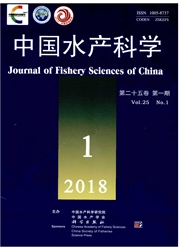

 中文摘要:
中文摘要:
为了从生理学角度探讨长牡蛎壳金选育系的快速生长机制,本研究以两种规格长牡蛎(Crassostrea gigas)第4代壳金选育系(简称金1和金2)和两种普通养殖群体(简称对照1和对照2)为材料,比较了不同温度(16℃、20℃、24℃、28℃、32℃)和盐度(15、20、25、30、35)条件下各实验组的滤水率(FR)和耗氧率(OCR)。结果显示:(1)摄食实验中,4个组长牡蛎的滤水率均随温度或盐度增加先上升后下降,在温度28℃时出现最大值;对照1的滤水率在盐度25时达到最大值,其他3组滤水率在盐度30时达到最大值;方差分析结果显示,温度、群体,盐度、群体对长牡蛎的滤水率均有显著性影响,长牡蛎壳金选育系的滤水率均显著大于普通养殖群体(P〈0.05)。(2)呼吸实验中,较大规格长牡蛎壳金选育系的耗氧率受温度或盐度变化的影响更小。方差分析结果显示,温度、群体,盐度、群体均对长牡蛎耗氧率有显著性影响。实验温度范围内,金1的耗氧率显著小于对照1,但金2的耗氧率显著大于对照2(P〈0.05)。实验盐度范围内,壳金选育系的耗氧率均显著大于普通群体(P〈0.05)。(3)同一壳色群体中,个体越大,单位软体部干重滤水率和耗氧率越低。研究表明,较大规格长牡蛎壳金选育系F4更能适应外部环境的变化,该选育系的快速生长可能是由其较高滤食行为导致的。
 英文摘要:
英文摘要:
In order to assess the effect of shell color selection of Pacific oyster (Crassostrea gigas) on feeding and respiration, two groups of the forth golden shell color line (G1, G2) and two groups of the normal culture group (C1, C2) were conducted in the experiment. Filtration rate (FR) and oxygen consumption rate (OCR) of 4 groups at different temperatures and salinities were observed. The results of feeding treatments showed that with the in-crease of temperature, FR began to rise reaching the maximum at 28℃, and then declined. C1 exhibited the maximum FR at salinity of 25 and other three groups exhibited the maximum FR at salinity of 30; Two-way ANOVA showed that temperature, group and salinity, group had a significant influence on FR ofC. gigas. Golden shell color line had significantly larger filtrate rate than the normal culture group (P〈0.05). The results of respira-tion treatments demonstrated that temperature, group and salinity, group had a significant effect on OCR of 4 groups (P〈0.05). The maximum OCR of G2 occurred at the temperature of 32℃, while other three groups oc-curred at the temperature of 28℃. OCR of G1was significantly lower than C1, while OCR of G2 was significantly higher than C2 (P〈0.05). In the set salinity range, all groups exhibited the maximum OCR at salinity of 25; OCR of golden shell color line was significantly higher than the normal culture group (P〈0.05). Oyster of small size filter and consume oxygen more than oyster of large size. The present results indicated that selection for faster growth of golden color line might produce animals that had higher intake of energy by virtue of faster filtrating behavior, and a further selection could be likely meaningful.
 同期刊论文项目
同期刊论文项目
 同项目期刊论文
同项目期刊论文
 期刊信息
期刊信息
